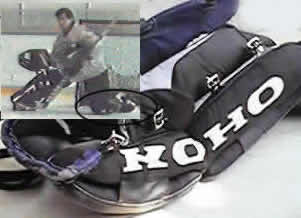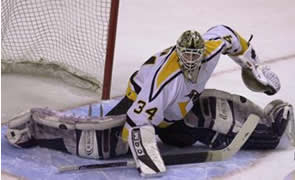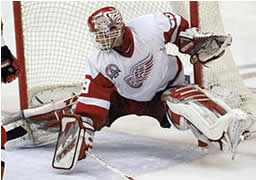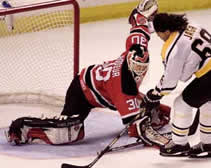 |
My
butterfly slide has been a work in progress for several years now. Below
is a strip from some video shot in 1997 and it is not very good. The hands,
the feet, everything is off. When Overdrive was legal in the NHL, I'd
travel down to Francois Allaire's pro camp to peddle the blade and after
seeing the goalies there, it slowly dawned on me that I was slightly behind
the times. Not wanting to make a fool of myself any longer, I got to work
on things in earnest in late '99. I'm mentioning this so that you'll have
an idea of how quickly you can improve things. Now I get complimented
on this move all the time but a lot of goalies think it's beyond them.
However, that's not true. My schedule isn't particularly rigorous. I work
at things regularly but since I'm not going anywhere in hockey except
to the rink and back, my pace isn't what you'd call feverish. I've pecked
away at this move for two years so although it looks difficult and may
start out being a bit of a mess, anyone who puts their time in will get
it. I should also mention that I'm not quite finished here. Shooting a
nice looking video clip is one thing but having the move work efficiently
in a game is another. I've made some minor changes since shooting the
video to get the feet snapping out a little cleaner and the move more
'game ready'. |
 |
Before we start, we should be sure exactly what a butterfly slide is and below is a link to a Flash piece showing my moves left and right. This page has eight movies and they're all linked using the Flash icon. Two of them have snappy preloaders that I made to keep myself entertained, so they should be ready quickly. I think it's best to open them and minimize them for a minute to get them started. In the meantime you could look at the other stuff on the page. Don't close them when you're done, just minimize them because you may want to go back to them before you leave the page. Most browsers will allow you to have quite a few separate boxes open. I used the latest Flash because it handles video so if you don't have the Flash 6 plugin, it won't work. 95% of net users have Flash and it's hard to go anywhere without it. It's a one minute download at Macromedia. |
Another
thing we should do before we start is to ask the question 'Is this move
worth the effort?' As I've gotten better with the Butterfly slide it has made a lot of difficult saves routine. Short passes across the crease, one-timers, small dekes and even breakaways are all a lot easier when the pad gets across quickly.
I
should say that I don't think much of the butterfly slide without Overdrive.
I rely heavily on Overdrive for this move. The pushing foot needs a very
secure grip because a lot of power goes into the move. Without Overdrive,
it's a much smaller move and you have to be very careful not to overload
the pushing foot and blow it out. A blowout here can spread you right
out and put a lot of pressure on the groin.
So let's get started. First, I'll look at how both feet should work. |
The key to a good butterfly slide is how the moving foot slides out. It is not an easy move to get right and chances are if you haven't focussed on the moving foot and worked on it a lot, it's not sliding properly. The best way for the foot to slide out is the one that efficiently provides the most coverage. That means the foot has to move so that the pad gives the most coverage it can throughout the slide. By implication, this means the ProFly style. The pictures below show that there is no comparison in coverage between the two styles. When the foot slides out, the ProFly presents the full face of the pad to the shooter (left) whereas with the traditional butterfly the pad is more face down and coverage is reduced (right). |
||
  |
||
| If things were as simple as adopting the ProFly then this would be a very short page but I also said that the best way must efficiently provide the best coverage and here's where even ProFly goalies can have problems. The shortest distance between two points is a straight line and that's how the moving foot has to slide. Since the butterfly slide is a lateral move the straight line has to be sideways: if you're sliding left, the left foot should slide straight out to the left. This sounds simple but it's not. Getting the foot to slide straight out sideways without lifting or backing up takes a lot of work. | ||
 |
Towards the end of the butterfly slide, the foot will fold back into a butterfly but the initial slide (1,2) of the moving foot (L) should be sideways whether you start in a wide stance (top) or a narrow stance (bottom). | |
So
what's the problem? |
|
| The problem is the main blade. Goalies always ask me if Overdrive will catch and hold up a move but few realize that this is exactly what the main blade often does. When the foot has to slide out, you have to scrape through the main blade before you get onto the side of your boot to slide on. | |
 |
Scraping
through the main blade |
  |
You have to work this move a lot in order to program in the weight shifts that will get the foot moving cleanly no matter how your weight is distributed. Once you get it, the scraping should almost disappear. If you haven't worked on this, it's likely that your feet are taking a detour to get out there. From beginners to pros, you'll see the feet lifting or backing up to avoid having to scrape through the main blade. Tape a game on TV and put it on frame-by-frame advance and you'll see it happening. The strip below shows me making this mistake.
|
 |
Frame #2: From the stance, the first thing I do is lift my heel and that's the first mistake. I've got to go to my blocker side so the first thing that should happen is my right foot pushes and my left foot slides out. There's never enough time out there so this move where my foot is lifting inwards instead of moving out is pure waste. Frames #3, 4: Instead of moving out in a straight line, my foot keeps backing up. My blocker is hanging back. Frame #5: My right foot has completely lifted out of the way and exposed everything along the ice. This is how goalies are always getting beaten by the old 'fake a big deke and slip it in through the legs'. The foot is lifting out of the way to get ready for the big slide out but is not covering short. Frame #6: Finally some coverage is down but it's taken a while. These are old shots and I'm not using the ProFly however, a lot of ProFly goalies will move like in frames 1-5.
|
| So lifting is the big problem with the pushing foot. You've got to maintain your coverage both short and long but this move won't do it. It takes too long to get going and opens up large holes. This can create insecurity and result in the goalie getting his feet tied up on the more difficult plays. |
|
So you can see that by keeping the main blade on the ice and scraping through it there are no gaping holes at the beginning, the move starts quicker and the result is much better short coverage. |
  |
One very minor thing you might want to be aware of is how the top of your pads are set for this move. Below, Turek's left pad is lower than his right. If he had to slide left, the pad wouldn't have a problem. However, if he had to slide right from that position, his right pad is higher and it wouldn't slide out as easily as moving the other way. Oftentimes, you'll have a split second before the shooter commits to drop the pad a bit to make sliding out easier, as Hasek might be doing here. However, do not get preoccupied with this. It's not something you should be thinking about in a game or you'll start letting in goals while you check the top of your pads. It'll come naturally through practice.
|
 |
|
|
| A lot of goalies avoid this move because of the stress on the groin. However, there are ways around it. My flexibility is very average and I'm always surprised when people infer that it is above average. On these two images, the feet are at the same width. The move on the left requires very good flexibility, the one on the right does not. This would be a slide to the goalie's right so the moving leg knee has dropped (better coverage along the ice also). This takes a lot of pressure off the groin. The catch is you need Overdrive to do it because the hips have to drop also. Lowering the hips decreases the leg angle on the pushing foot and makes a blowout as you push through more likely if you don't have Overdrive; you can't lower your center of gravity to make this adjustment. |
  |
 |
The only problem you can get from the pushing foot is that you don't make full use of Overdrive. A lot of goalies will get this on one or both feet and it can take a bit of work to ensure sufficient power for the bigger moves.At the end of the move, make sure that the pad folds into a proper butterfly and try to keep some flare for width. For reversing direction, the other foot does most of the work but see that the leg is ready. |
 |
| The butterfly slide can stress the groin quite a bit but there are ways to minimize it. One thing you can try is to turn up the toe up on the pushing foot after you push off. This turns the leg and hips so instead of pulling on both groins, you're now pulling on one groin and one hamstring. It not only makes widening out less stressful but also easier. As you go into your recovery you'll find that it's easy to get the foot back in position. |
   |
|
It's absolutely essential that your hands cover properly on this move. It's not enough to get the pad across because any shooter can roof the puck. It's a different story if the hands get across as well. You'll get shooters hesitating or going too high and you'll be amazed at how many pucks end up in your trapper for a pretty cool looking save. Again, goalies without Overdrive are at a disadvantage here because the hands will be all over the place to maintain balance so it'll be hard controlling them. |
|
| Getting the blocker over isn't too hard but there are problems to be aware of. The blocker should sit on top of the pads. If it's too high up, everything will go under it or through the 14 hole (between the arm and the body). Also, if you reach over to get the blocker close to your feet, you'll be opening up your 14 hole and the 5 hole, since the stick has moved as well. If you keep your blocker tight to the body then you may not get the quick one timers that go straight up over the pads near your feet. It's your call. You can't cover everything but keep it tight. |
   |
| 1:
Theodore's legs are always in the right spot but without the blocker there,
the shooter will have an easy time. 2: Again, if the blocker was there,
the guy with the hair might have to work for his goal. 3: Hackett has this one but the photo shows why it's better to have the blocker down a bit more. |
|
| Positioning of the trapper is simple. It just sits on top of the pads. At first, I had a lot of trouble getting it to stay there but practice eventually fixed things and as I said before, it's great the way pucks end up in there. I just drop the leg and trapper back and I get these saves that look good but aren't that hard. |
   |
| 1:Perfect form by Kochan, but I bet that right foot didn't start there and slipped back. 2: If Shields could get that trapper just a little more forward the shooter would have a lot of trouble beating him. 3: Excellent effort by Lalime. |
![]()



